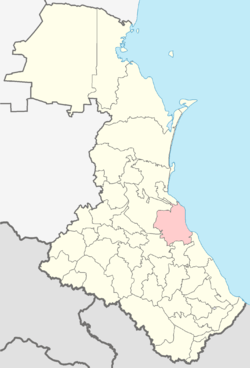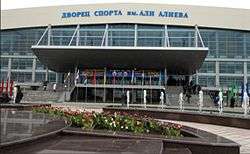Karabudakhkentsky District
| Karabudakhkentsky District Карабудахкентский район (Russian) Къарабудахгентли якъ (Kumyk) | |
|---|---|
 Location of Karabudakhkentsky District in the Republic of Dagestan | |
| Coordinates: 42°42′N 47°33′E / 42.700°N 47.550°ECoordinates: 42°42′N 47°33′E / 42.700°N 47.550°E | |
 Sports complex, Karabudakhkentsky District | |
.png) | |
|
| |
| Location | |
| Country | Russia |
| Federal subject | Republic of Dagestan[1] |
| Administrative structure (as of December 2013) | |
| Administrative center | selo of Karabudakhkent[1] |
| Administrative divisions:[2] | |
| Settlements | 2 |
| Selsoviets | 3 |
| Inhabited localities:[2] | |
| Urban-type settlements[3] | 2 |
| Rural localities | 16 |
| Municipal structure (as of October 2012) | |
| Municipally incorporated as | Karabudakhkentsky Municipal District[4] |
| Municipal divisions:[4] | |
| Urban settlements | 2 |
| Rural settlements | 12 |
| Statistics | |
| Area | 1,460 km2 (560 sq mi)[5] |
| Population (2010 Census) | 73,016 inhabitants[6] |
| • Urban | 9.6% |
| • Rural | 90.4% |
| Density | 50.01/km2 (129.5/sq mi)[7] |
| Time zone | MSK (UTC+03:00)[8] |
| Established | January 20, 1921 |
| Previous names | Leninsky District (until 1992) |
| Official website | |
| Karabudakhkentsky District on WikiCommons | |
| 2010 Census | 73,016[6] |
|---|---|
| 2002 Census | 60,620[9] |
| 1989 Census | 39,486[10] |
| 1979 Census | 35,705[11] |
Karabudakhkentsky District (Russian: Карабудахкентский райо́н, Kumyk: Къарабудахгентли якъ) is an administrative[1] and municipal[4] district (raion), one of the forty-one in the Republic of Dagestan, Russia. It is located in the east of the republic. The area of the district is 1,460 square kilometers (560 sq mi).[5] Its administrative center is the rural locality (a selo) of Karabudakhkent.[1] As of the 2010 Census, the total population of the district was 73,016, with the population of Karabudakhkent accounting for 21.0% of that number.[6]
History
The district was established by the Central Executive Committee decree on January 20, 1921.[12] It underwent numerous changes during the following years and was established in its present borders in 1965 as Leninsky District (Ле́нинский райо́н).[12] In 1992, it was renamed Karabudakhkentsky District.[12]
Administrative and municipal status
Within the framework of administrative divisions, Karabudakhkentsky District is one of the forty-one in the Republic of Dagestan.[1] It is divided into two settlements (administrative divisions with the administrative centers in the urban-type settlements (inhabited localities) of Achi-Su and Manas) and three selsoviets, which comprise sixteen rural localities.[2] As a municipal division, the district is incorporated as Karabudakhkentsky Municipal District.[4] The settlements are incorporated as urban settlements, and the three selsoviets are incorporated as twelve rural settlements within the municipal district.[4] The selo of Karabudakhkent serves as the administrative center of both the administrative[1] and municipal[13] district.
References
Notes
- 1 2 3 4 5 6 Law #16
- 1 2 3 Государственный комитет Российской Федерации по статистике. Комитет Российской Федерации по стандартизации, метрологии и сертификации. №ОК 019-95 1 января 1997 г. «Общероссийский классификатор объектов административно-территориального деления. Код 82 235», в ред. изменения №275/2015 от 1 сентября 2015 г.. (State Statistics Committee of the Russian Federation. Committee of the Russian Federation on Standardization, Metrology, and Certification. #OK 019-95 January 1, 1997 Russian Classification of Objects of Administrative Division . Code 82 235, as amended by the Amendment #275/2015 of September 1, 2015. ).
- ↑ The count of urban-type settlements may include the work settlements, the resort settlements, the suburban (dacha) settlements, as well as urban-type settlements proper.
- 1 2 3 4 5 Law #6
- 1 2 "General Information" (in Russian). Karabudakhkentsky District. Retrieved January 20, 2017.
- 1 2 3 Russian Federal State Statistics Service (2011). "Всероссийская перепись населения 2010 года. Том 1" [2010 All-Russian Population Census, vol. 1]. Всероссийская перепись населения 2010 года (2010 All-Russia Population Census) (in Russian). Federal State Statistics Service. Retrieved June 29, 2012.
- ↑ The value of density was calculated automatically by dividing the 2010 Census population by the area specified in the infobox. Please note that this value is only approximate as the area specified in the infobox does not necessarily correspond to the area of the entity proper or is reported for the same year as the population.
- ↑ Правительство Российской Федерации. Федеральный закон №107-ФЗ от 3 июня 2011 г. «Об исчислении времени», в ред. Федерального закона №271-ФЗ от 03 июля 2016 г. «О внесении изменений в Федеральный закон "Об исчислении времени"». Вступил в силу по истечении шестидесяти дней после дня официального опубликования (6 августа 2011 г.). Опубликован: "Российская газета", №120, 6 июня 2011 г. (Government of the Russian Federation. Federal Law #107-FZ of June 31, 2011 On Calculating Time, as amended by the Federal Law #271-FZ of July 03, 2016 On Amending Federal Law "On Calculating Time". Effective as of after sixty days following the day of the official publication.).
- ↑ Russian Federal State Statistics Service (May 21, 2004). "Численность населения России, субъектов Российской Федерации в составе федеральных округов, районов, городских поселений, сельских населённых пунктов – районных центров и сельских населённых пунктов с населением 3 тысячи и более человек" [Population of Russia, Its Federal Districts, Federal Subjects, Districts, Urban Localities, Rural Localities—Administrative Centers, and Rural Localities with Population of Over 3,000] (XLS). Всероссийская перепись населения 2002 года [All-Russia Population Census of 2002] (in Russian). Retrieved August 9, 2014.
- ↑ Demoscope Weekly (1989). "Всесоюзная перепись населения 1989 г. Численность наличного населения союзных и автономных республик, автономных областей и округов, краёв, областей, районов, городских поселений и сёл-райцентров" [All Union Population Census of 1989: Present Population of Union and Autonomous Republics, Autonomous Oblasts and Okrugs, Krais, Oblasts, Districts, Urban Settlements, and Villages Serving as District Administrative Centers]. Всесоюзная перепись населения 1989 года [All-Union Population Census of 1989] (in Russian). Институт демографии Национального исследовательского университета: Высшая школа экономики [Institute of Demography at the National Research University: Higher School of Economics]. Retrieved August 9, 2014.
- ↑ "Всесоюзная перепись населения 1979 г. Национальный состав населения по регионам России. (All Union Population Census of 1979. Ethnic composition of the population by regions of Russia.)". Всесоюзная перепись населения 1979 года (All-Union Population Census of 1979) (in Russian). Demoscope Weekly (website of the Institute of Demographics of the State University—Higher School of Economics. 1979. Retrieved 2008-11-25.
- 1 2 3 "History of the Region". Official website of Karabukhkensky District. Karabudakhkensky District. Retrieved 25 January 2017.
- ↑ Федеральная служба государственной статистики. Федеральное агентство по технологическому регулированию и метрологии. №ОК 033-2013 1 января 2014 г. «Общероссийский классификатор территорий муниципальных образований. Код 82 635». (Federal State Statistics Service. Federal Agency on Technological Regulation and Metrology. #OK 033-2013 January 1, 2014 Russian Classification of Territories of Municipal Formations. Code 82 635. ).
Sources
- Народное Собрание Республики Дагестан. Закон №16 от 10 апреля 2002 г. «Об административно-территориальном устройстве Республики Дагестан», в ред. Закона №106 от 30 декабря 2013 г. «О внесении изменений в некоторые законодательные акты Республики Дагестан». Вступил в силу со дня официального опубликования. Опубликован: "Дагестанская правда", №81, 12 апреля 2002 г. (People's Assembly of the Republic of Dagestan. Law #16 of April 10, 2002 On the Administrative-Territorial Structure of the Republic of Dagestan, as amended by the Law #106 of December 30, 2013 On Amending Various Legislative Acts of the Republic of Dagestan. Effective as of the day of the official publication.).
- Народное Собрание Республики Дагестан. Закон №6 от 13 января 2005 г. «О статусе и границах муниципальных образований Республики Дагестан», в ред. Закона №43 от 30 апреля 2015 г. «О статусе городского округа с внутригородским делением "Город Махачкала", статусе и границах внутригородских районов в составе городского округа с внутригородским делением "Город Махачкала" и о внесении изменений в отдельные законодательные акты Республики Дагестан». Вступил в силу со дня официального опубликования. Опубликован: "Дагестанская правда", №8, 15 февраля 2005 г. (People's Assembly of the Republic of Dagestan. Law #6 of January 13, 2005 On the Status and Borders of the Municipal Formations of the Republic of Dagestan, as amended by the Law #43 of April 30, 2015 On the Status of the "City of Makhachkala" Urban Okrug with Intra-Urban Divisions, the Status and the Borders of the Intra-City Districts Comprising the "City of Makhachkala" Urban Okrug with Intra-Urban Divisions, and on Amending Various Legislative Acts of the Republic of Dagestan. Effective as of the day of the official publication.).